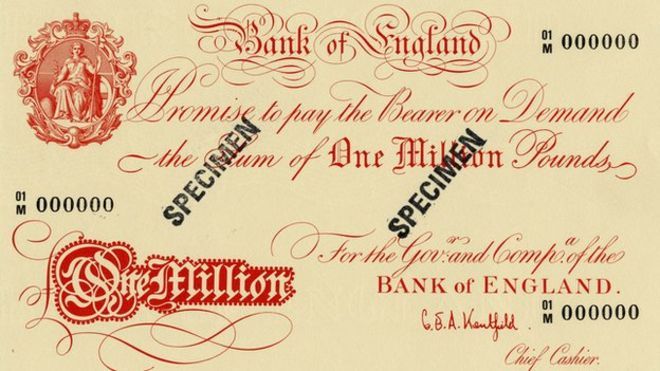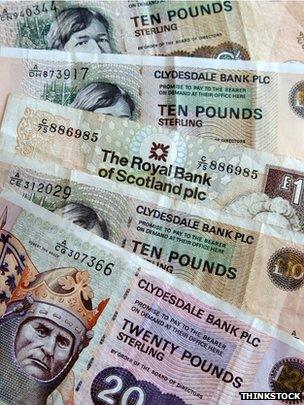Britain’s £1m and £100m banknotes

The Secret World of Million-Pound Banknotes
Deep inside the Bank of England’s vaults lie a handful of enormous banknotes. Known as “giants” and “titans,” they aren’t for public use — and for good reason. Each represents a staggering sum of money most people can only dream of.
Do These Notes Really Exist?
“Everyone thinks a £1 million note is a fantastic thing,” says Barnaby Fall, head of the banknote department at auction house Spink.
“What most people don’t realize is they actually exist.”
But you won’t find a “giant”—the” nickname for the £1 million note — at a cash machine. It’s hard to imagine anyone carrying one in their wallet or having the bank balance to match.
Even more astonishing is the “titan,” a banknote worth £100 million. While both are useless in everyday transactions, they play a critical role behind the scenes.
Why Do We Need Giants and Titans?
These massive banknotes help support the regular currency issued by commercial banks in Scotland and Northern Ireland.
Scottish and Northern Irish notes can be met with skepticism in England. To ensure trust in their value, banks must back every pound they issue with an equivalent deposit at the Bank of England.
If a Scottish bank were to fail, the Bank of England could step in and replace its notes with standard currency.
Victoria Cleland, head of notes at the Bank of England, explains:
“In the event of a bank’s failure, people can still trust that their notes are worth what they say.”
How Are They Stored?
Scottish and Northern Irish banks fund the creation of these large notes. The Bank of England prints them internally rather than through commercial printers. Once produced, the notes are stored securely.
Cleland adds that this system is much more efficient than keeping thousands of cages of regular notes scattered across the UK. In today’s unpredictable financial climate, this centralized backup matters more than ever.
Rare Escapes from the Vault
On rare occasions, older £1 million notes have made it out of the vaults.
Faull recalls one linked to the Marshall Plan, the US’s post-war aid to Britain. The Bank of England had given the note to a retiring chief cashier. Years later, his widow offered it for sale.
“When that happened,” Faull says, “the Bank of England asked us not to publicise the sale. Million-pound notes weren’t supposed to be seen in public.”

Independence and the Future of Giants and Titans
The system supported by today’s giants and titans could soon face fresh scrutiny. Scotland is set to vote on independence next year, and the Scottish National Party has proposed a plan: remain part of the sterling zone by arranging an agreement with the rest of the UK and the Bank of England.
Will Sterling Support Remain?
Some question whether political independence might cast doubt on the extent of London’s financial support for Scotland. In times of financial crisis, such uncertainty can be dangerous.
Although Scottish banknotes represent a symbol of national identity, irony lies in the fact that an independent Scotland might be better off using Bank of England-issued currency. Doing so could eliminate any financial doubt.
Angus Armstrong, an economist at the National Institute of Economic and Social Research and a former senior Treasury official, points out the paradox:
“Some freedoms you currently enjoy may become unavailable to you.”
Would Giants and Titans Still Be Needed?
If Scotland stops issuing its own banknotes, giants and titans may no longer be necessary to back them. That raises an interesting question: could these high-value notes take on new, more public roles?
A Note That Changes Everything
Author Mark Twain explored this idea in his short story The Million Pound Banknote, later adapted into a film starring Gregory Peck. In the story, a poor sailor receives a £1 million note without knowing he’s part of a wager between two wealthy brothers.
One brother claims the note is useless. The other believes its sheer presence will grant the sailor unlimited credit, as everyone assumes he must be rich. The story imagines the power of money — not in spending but in symbolism.
Could High-Value Notes Return?
Britain could theoretically see the return of massive notes if it ever faced hyperinflation. As a reminder of how bad that can get, the Bank of England Museum displays a 20 billion mark note issued in Germany in the 1920s.
For now, though, giants and titans remain quiet but essential parts of the financial system — secure, unseen, and stabilizing.
A Royal Encounter
When Queen Elizabeth visited the Bank of England in December, she signed a decorative £1 million note. It wasn’t officially issued, but it’s now on display at the museum.
As for the public? We’ll have to make do with fivers, tenners, twenties, fifties — and, in Scotland, the occasional hundred. learn more or visit our store

